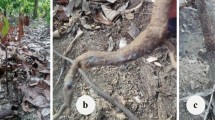Abstract
DURING a visit to some estates in Central Travancore in October 1951, my attention was directed to a small patch of unthrifty tea on one of the estates. The bushes appeared ‘thin’, with weak development of the branches and only a crown of unhealthy foliage. Examination of the aerial parts did not reveal any sign of insect damage or fungal attack. The roots, however, showed certain characteristic symptoms, namely, the entire absence of feeding roots and the presence of circular or slightly elongated and raised patches all over the bark of the tap and lateral roots (see photograph), and also extending to the collar—a feature not associated with any of the known root diseases of tea. The lesions varied in size from minute spots to small patches measuring 2–15 mm. across. The discoloration of the bark in the affected regions extended to a few cells only in the case of the small spots, while in the larger lesions the entire depth of the bark was affected and the wood too was occasionally seen to be discoloured just below the necrotic area on the bark. In some cases the affected bark had fallen off leaving a shallow scar or depression on the root surface. These external symptoms agreed to some extent with the verbal description of a Plasmodiophora root disease of tea reported from Assam in 1948 (private communication from the Directorate of Plant Protection, Ministry of Agriculture, Government of India). As no species of Plasmodiophora was evident in the South Indian material, it was sent to the Commonwealth Mycological Institute, Kew, for examination. While confirming the absence of Plasmodiophora, an apparently distinct species of Cylindrocladium was reported as being associated with the lesions on the root. Since sending the material to Kew, I have been able to isolate the fungus from the small spots on the diseased roots.
Similar content being viewed by others
References
Mehta, P. R., and Bose, S. K., Ind. J. Agric. Sci., 17, 219 (1947).
Loos, C. A., Tea Res. Inst. Ceylon, Ann. Rep. for 1949, Bull. 31, 42 (1951).
Sherbakoff, C. D., Phytopath., 18, 219 (1928) (R.A.M., 7, 508).
Boedijn, K. B., and Reitsma, J., Reinwardtia, 1, 51 (1950) (R.A.M., 30, 345.)
Wormald, H., J. Pomol., 20, 80 (1943) (R.A.M., 23, 30.)
Vanderwalle, R., Parasitica, 5, 5 (1949) (R.A.M., 28, 527).
Truscott, J. H. L., Canad. J. Res., 11, 1 (1934) (R.A.M., 13, 785).
Arruda, S. C., Biológico, 9, 140 (1943) (R.A.M., 22, 505).
Jauch, C., Rev. argent. Agron., 10, 355 (1943) (R.A.M., 23, 135).
Sadasivan, T. S., Ann. App. Biol., 26, 497 (1939).
Subramanian, C. V., J. Ind. Bot. Soc. (M.O.P. Iyengar Commem. Vol.), 209 (1946).
Author information
Authors and Affiliations
Rights and permissions
About this article
Cite this article
VENKATARAMANI, K. A Tea Root Disease New to South India. Nature 169, 1099–1100 (1952). https://doi.org/10.1038/1691099b0
Issue Date:
DOI: https://doi.org/10.1038/1691099b0
- Springer Nature Limited





